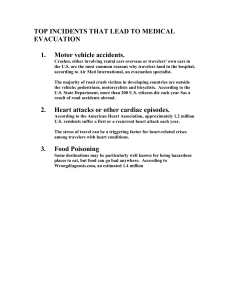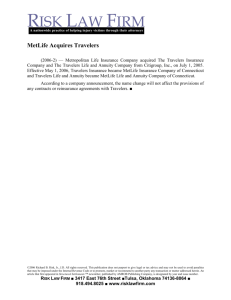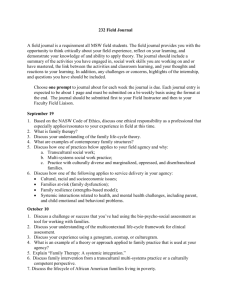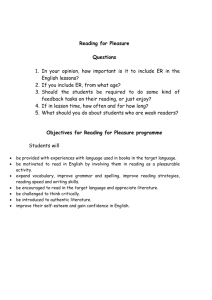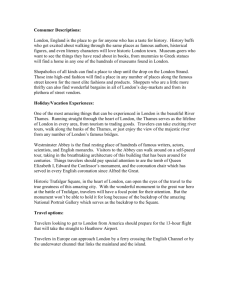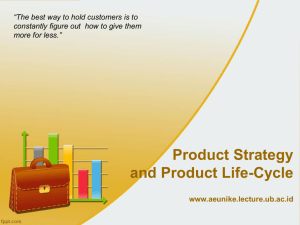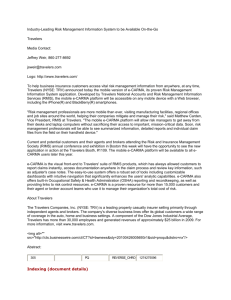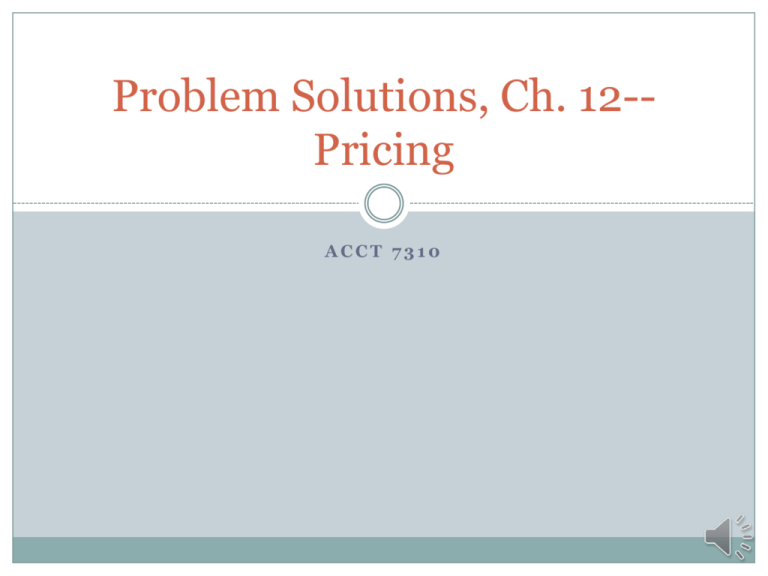
Problem Solutions, Ch. 12-Pricing
ACCT 7310
Pr. 12-17—Relevant Costing, Short-run pricing
Analysis of special order:
Sales, 3,000 units $75
Variable costs:
Direct materials, 3,000 units $35
Direct manufacturing labor, 3,000 units $10
Variable manufacturing overhead, 3,000 units $6
Other variable costs, 3,000 units $5
Sales commission
Total variable costs
Contribution margin
$225,000
$105,000
30,000
18,000
15,000
8,000
Flat amt
176,000
$ 49,000
Note that the variable costs, except for commissions, are affected by production volume, not
sales dollars.
If the special order is accepted, operating income would be $1,000,000 + $49,000 =
$1,049,000.
Part 2—add’l considerations
12-33: Cost-plus and market-based prices
1. Single rate =$1,262,460/106,000 = $11.91 per
test-hour (TH)
With 45% markup, hourly billing rate for HTT and ACT
= $11.91 * 1.45 = $17.27
2. Individual activity rates:
Labor and supervision =491,840/106,000 = $4.64 per
test-hour
Setup and facility costs =$402,620/800 = $503.275 per
setup-hour
Utilities =$360,000/10,000 = $36.80 per machine-hour
(MH)
Pr 12-33 part 3
106,000 hrs
*60% = 63,600
HTT
Labor and supervision
($4.64×63,600; 42,400 test-hrs)
$295,104
Setup and facility cost [25%/75%]
($503.275×200; 600 setup-hrs)
Utilities
($36.80×5,000; 5,000 machinehours)
Total cost
Number of testing hours (TH)
Cost per testing hour
Mark-up
Billing rate per testing hour
100,655
ACT
Total
$196,736 $ 491,840
301,965
402,620
368,000
$
184,000
$579,759
÷ 63,600 TH
$9.12 per TH $
× 1.45
13.22 per TH $
184,000
$682,701 $1,262,460
÷ 42,400 TH
16.10 per TH
× 1.45
23.35 per TH
Vs. $17.27 for either one
Pr 12-33 part 4
If competitors all charge $20/hr. for arctic testing,
what can Best Test do to stay competitive?
They apparently need to be more efficient in arctic testing.
Roughly 44% of arctic testing’s total cost occurs in setups and
facility costs. Can the setup activity can be redesigned to
achieve cost savings?
Also look for savings in the labor and supervision cost per testhour and the total number of test-hours used in arctic testing,
as well as the utility cost per machine-hour and the total
number of machine hours used in arctic testing.
This may require redesigning the test, redesigning processes,
and achieving efficiency and productivity improvements.
Pr. 12-34: Life-cycle costing
Part 1
Total Project Life-Cycle Costs
Variable costs:
Metal extraction and processing ($100/ton × 50,000 tons)
$5,000,000
Fixed costs:
Metal extraction and processing ($4,000 × 24 months)
96,000
Rent on temporary buildings ($2,000 × 27 months)
54,000
Administration ($5,000 × 27 months)
Clean-up ($30,000 × 3 months)
135,000
90,000
Land restoration
475,000
Selling land
150,000
Total life-cycle cost
$6,000,000
Pr. 12-34 part 2
Projected Life Cycle Income Statement
Revenue ($150 per ton 50,000 tons)
$7,500,000
Sale of land (plug figure)
500,000
Total life-cycle cost
(6,000,000)
Life-cycle operating income ($40/ton × 50,000
tons)
Mark-up percentage on project life-cycle cost =
Life cycle operating income
Total live-cycle cost
$2, 000, 000
$6, 000, 000
= 33 1/3 %
$2,000,000
Pr. 12-34 part 3
Revenue ($140 per ton 50,000 tons)
Sale of land [$100,000 less than in part 3]
Total revenue
Total life-cycle cost allowable given mark-up of 33⅓%
($7,400,000 ÷ 1.333333)
This is a reduction in total life-cycle costs of
($6,000,000 – $5,550,000) =
$7,000,000
400,000
$7,400,000
$5,550,000
$ 450,000
Checking the answer:
Revenue
Sale of land
Total life-cycle cost
Life-cycle operating income
Mark-up percentage = 1,850000/5,550,000= 33⅓%
$7,000,000
400,000
(5,550,000)
$1,850,000
Pr. 12-35: Airline Pricing
If the fare is $500,
Air Eagle would expect to have 200 business and 100 pleasure travelers.
Variable costs per passenger would be $65.
Contribution margin per passenger = $500 – $65 = $435.
If the fare is $2,100,
Air Eagle would expect to have 180 business and 20 pleasure travelers.
Variable costs per passenger would be $175.
Contribution margin per passenger = $2,100 – $175 = $1,925.
Fare
Business fliers
Pleasure fliers
$500
200 @$435
=$87,000
100@$435
= $43,500
$130,500
$2,100
180 @$1,925
= $346,500
20 @$1,925
= $38,500
$385,000
Pr. 12-35: Airline Pricing
If the fare is $500, expect to have 200 business and 100 pleasure travelers.
Variable costs per passenger would be $65. CM/passenger = $500 – $65 = $435.
If the fare is $2,100, expect to have 180 business and 20 pleasure travelers.
VC/ passenger would be $175. CM/passenger = $2,100 – $175 = $1,925.
Fare
Business fliers
Pleasure fliers
$500
200 @$435
=$87,000
100@$435
= $43,500
$130,500
$2,100
180 @$1,925
= $346,500
20 @$1,925
= $38,500
$385,000
$346,500
$43,500
$390,000
Potential with
discrimination
Note: In deciding the prices, all other costs such as fuel costs, allocated annual lease costs,
allocated ground services costs, and allocated flight crew salaries are irrelevant. They will not
change whatever price Air Eagle charges.
Pr. 12-35 part 3: How can price discrimination work?
The elasticity of demand of the two classes of passengers drives the
different demands of the travelers. Business travelers are relatively price
insensitive because they must get to their destination during the week
(exclusive of weekends) and their fares are paid by their companies. A
320% increase in fares from $500 to $2,100 will deter only 10%
of the business passengers from flying with Air Eagle. A similar fare
increase will lead to an 80% drop in pleasure travelers who are paying
for their own travels, unlike business travelers, and who may have
alternative vacation plans they could pursue instead.
Since business travelers often want to return within the same week, while
pleasure travelers often stay over weekends, a requirement that a
Saturday night stay is needed to qualify for the $500 discount fare
would discriminate between the passenger categories. This price
discrimination is legal because airlines are service companies rather
than manufacturing companies and because these practices do not, nor are
they intended to, destroy competition.
IMA Code of Conduct (Ch. 1 of Horngren et al. and just
about any other cost/managerial accounting textbook
The four standards of ethical conduct for
management accountants as advanced by the
Institute of Management Accountants:
Competence
Confidentiality
Integrity
Objectivity
© 2012 Pearson Prentice Hall. All rights reserved.
Competence
Members have a responsibility to:
1. Maintain an appropriate level of professional expertise
by continually developing knowledge and skills.
2. Perform professional duties in accordance with
relevant laws, regulations, and technical standards.
3. Provide decision support information and recommendations
that are accurate, clear, concise, and timely.
4. Recognize and communicate professional limitations
or other constraints that would preclude responsible
judgment or successful performance of activity.
Confidentiality
Members have a responsibility to:
1. Keep information confidential except when disclosure
is authorized or legally required.
2. Inform all relevant parties regarding appropriate use
of confidential information.
3. Refrain from using confidential information for unethical
or illegal advantage.
4. Monitor subordinates’ activities to ensure compliance.
Integrity
Members have a responsibility to:
1. Mitigate actual conflicts of interest, regularly communicate
with business associates to avoid apparent conflicts of
interest. Advise all parties of any potential conflicts.
2. Refrain from engaging in any conduct that would prejudice
carrying out duties ethically.
3. Abstain from engaging in or supporting any activity that
might discredit the profession.
Credibility
Members have a responsibility to:
1. Communicate information fairly and objectively.
2. Disclose all relevant information that could reasonably
be expected to influence an intended user’s understanding
of the reports, analyses, or recommendations.
3. Disclose delays or deficiencies in information, timeliness,
processing, or internal controls in conformance with
organization policy and/or applicable law.
12-36: Ethics & Pricing
1.
The $500 spent on the basketball tickets is a
sunk (past) cost, and is therefore irrelevant to the bid
decision. Apex will incur the $500 cost whether it
bids, loses the bid, or wins the bid.
This is not a key part of the problem’s focus.
12-36: Ethics & Pricing
2. Target price = $145,000
Full cost allowed with 25% markup: $145,000/125% =
$116,000
Original full cost was $121,000, so this is a $5000
reduction
Taken from framing costs, $40,000-$5000 = $35,000
target cost of frames.
12-36: Ethics & Pricing
It was unethical for Grant to use the basketball
tickets to get the tip out of the purchasing agent.
Knowing about Grant’s action and suggesting a way
to use it is unethical on the part of Gomes. In
assessing the situation, the specific “Standards of
Ethical Conduct for Management Accountants,”
described in Chapter 1 that the management
accountant should consider are listed below.
Conclusions based on IMA Code
Integrity
The management accountant has a responsibility to avoid actual or
apparent conflicts of interest and advise all appropriate parties
of any potential conflict. Using unethically gathered information to
compromise a sealed bid arrangement is clearly a violation of this standard.
The Standards of Ethical Conduct require the management accountant to
communicate favorable as well as unfavorable information. In this regard,
both Grant’s and Gomes’s behavior could be viewed as unethical.
Credibility
The Standards of Ethical Conduct for Management Accountants require
that information should be fairly and objectively communicated and that all
relevant information should be disclosed. From a management
accountant’s standpoint, revising a bid based on this kind of
information violates both of these precepts.
Grant and Gomes should leave the bid as it was originally produced,
without using the unethically obtained inside information. The company
should clarify its policy on business entertainment.

